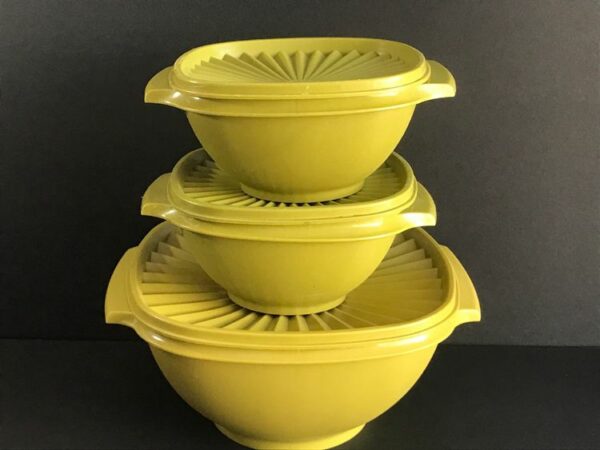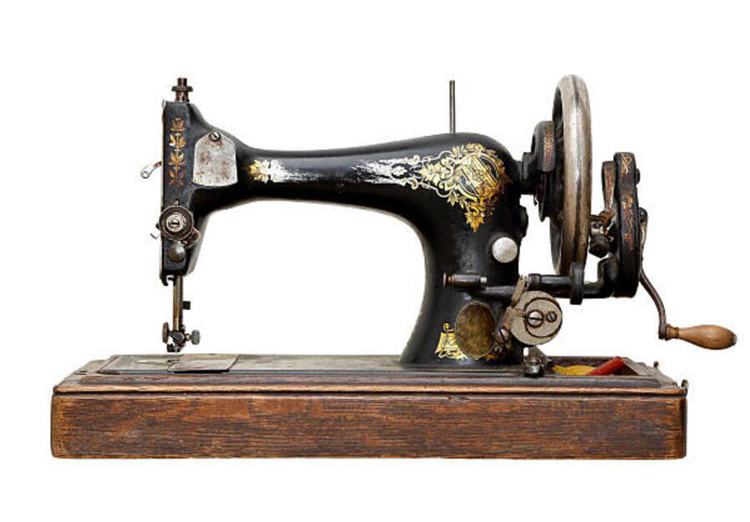
Vintage sewing machines are real workhorses. They lack the bells and whistles of modern computerized sewing machines, but they are built to last.
White sewing machines, like any antique vintage machines, may survive forever if properly cared for.
Hundreds of sewing machine makers have produced equipment for quick stitching. However, few are as well-known as the White Sewing Machine Company, which has been producing the machines for almost a century.
Even though they are no longer in business, their antique sewing machines are still popular and highly sought on internet marketplaces.
Table of Contents
The History Of White Sewing Machines
In the 1860s, Thomas White created the sewing machine. Because it was a hand-cranked machine that could only stitch straight seams, it wasn’t as useful as current sewing machines.
Furthermore, because it was hand-cranked, using it for lengthy periods was incredibly exhausting.
Foot-pedal-powered devices, on the other hand, quickly followed and became one of the most popular inventions in the United States.
Thomas White established the White Sewing Machine Company in Templeton, Massachusetts, in 1858, to mass-produce his clever sewing machine.
The White Sewing Machine Company expanded to become one of the most dominant players in the sewing machine industry, with sister companies in the automotive industry. It was manufacturing roughly 60,000 sewing machines per year by the 1880s.
However, it began to lose revenue in the 1950s as competitors such as Sears, Singers Corporation, and Co began and Roebuck began to win over consumers with cheaper and better sewing machines.
Regardless, White sewing machines are among the most popular antique sewing machines available today.
Because of their durability and ease of use, they are still widely utilized by hobbyists and professionals.
White Sewing Machine Company
Thomas Howard White, who was mechanically adept and naturally ambitious, experimented with crazy ideas in his free time.
It was the era of invention, and one of the most fascinating gadgets to hit the market was the sewing machine.
He patiently experimented with this promising technology, eventually developing his own little hand-powered sewing machine in 1857, for which he got a patent in 1859.
With a $350 capital and William Grout as a salesperson as a partner, Thomas Howard White began manufacturing sewing machines in Templeton in 1858.
This machine was called “The New England,” and it cost 10 dollars to buy. Even though White’s relationship with Grout lasted barely a year, the firm thrived, and by 1863, demand had increased to the point that White relocated to a larger factory in Orange, Massachusetts, where he made for three years.
White started the White Manufacturing Company in Cleveland, Ohio, with a handful of his top specialists, in 1866.
For fifteen years, the new plant produced sewing machine heads for W. G. Wilson until that company purchased the existing patterns, and special equipment and established an independent operation in Chicago.
The Year 1876
When most of the “Combination” patents expired in 1876, two workers, D’Arcy Porter and George W. Baker invented the new machine that became the company’s hallmark product.
The company, which had 600 employees, was incorporated and given the name White Sewing Machine Co.
The new sewing machine was initially called the “White SMC,” but was subsequently renamed “White.”
A large network of branch dealers was formed in the United States, and the company’s overseas commerce expanded significantly after the creation of a London office in 1880.
The “White Vibrating Shuttle Sewing Machine” received an upgrade in 1883.
The White firm had 500.000 machines in operation in 1884.
The company’s vibrating-shuttle type was complemented in the late 1890s with a new rotary variant, first called the “White Family Rotary.”
It became the most popular White model and was produced by the business in several versions until the 1950s.
The business developed its first vehicle in 1901. Thomas White, still the company’s president, delegated management of car manufacturing to his three sons, Rollin, Windsor, and Walter.
The firm manufactured “One Million 500.000” sewing machines in 1902.
While the founder’s true passion was sewing machines, which he pursued numerous improvements in, his sons were interested in other sorts of technology, such as steam-powered autos.
The corporation had rapid expansion in the early twentieth century. Indeed, White began diversifying in 1903, producing automated lathes, roller skates, kerosene lights, and even automobiles.
When White’s sons couldn’t persuade their father that the steam vehicle was worth keeping in production, Windsor and Walter White separated it apart from White, forming the White Motor Corporation in 1906.
Vintage White Sewing Machine Models
Unlike their primary competition Singer Corporation, White Sewing Machine Company did not develop a wide range of models over the years.
However, it’s still worth looking at some of the most popular White sewing machine models and seeing how they’ve evolved through time.
White Peerless Sewing Machine
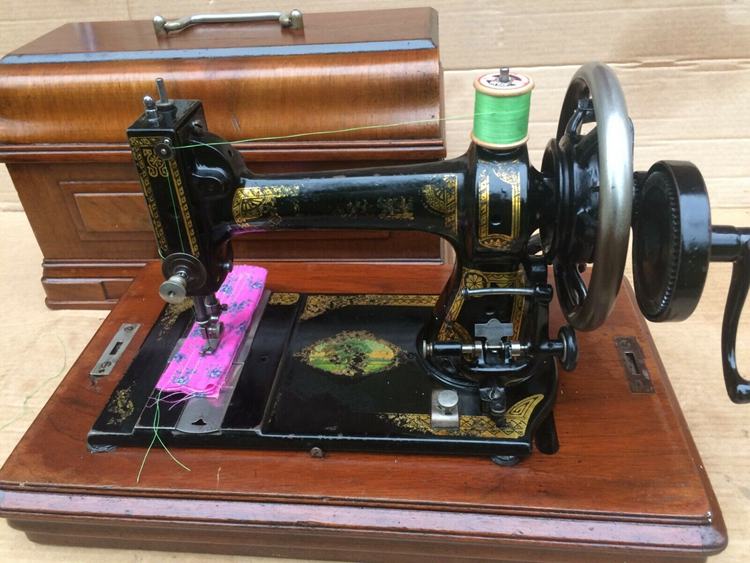
Features: Hand Crank, Bobbin-Winding, Portable(Source: eBay)
This is most likely the most popular sewing machine model produced by White Sewing Machine Company.
It was made from the late 1800s to the first part of the 1900s and is distinguished by a landscape painting at the base.
All Peerless sewing machines were hand-cranked and available in 34-size models for both experts and hobbyists.
Furthermore, the New White Peerless was built on the VS III model, which was manufactured between 1893 and 1928.
The final Peerless model was available in three variants: “A,” “B,” and “C,” which vary in the casing and hand-crank design.
White Rotary Sewing Machine
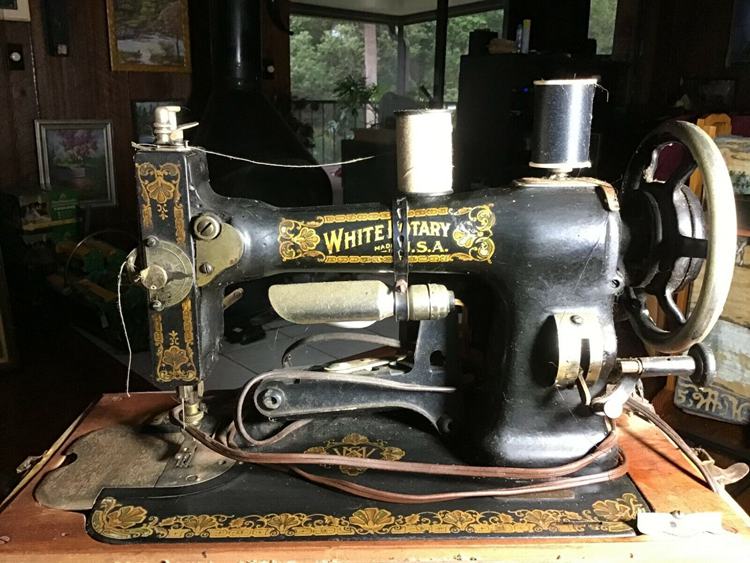
This style of the sewing machine was made by White beginning in the late 1890s and remained popular until the 1950s when new sewing machine models replaced it.
Because of their long period of dominance, white rotary sewing machines are widely available and inexpensive. There were two types: treadle and electric, with the latter being more popular.
There were numerous variants of this kind, including 41, 43, and 77, which changed somewhat in design aspects but otherwise are very similar.
White Gem Sewing Machine
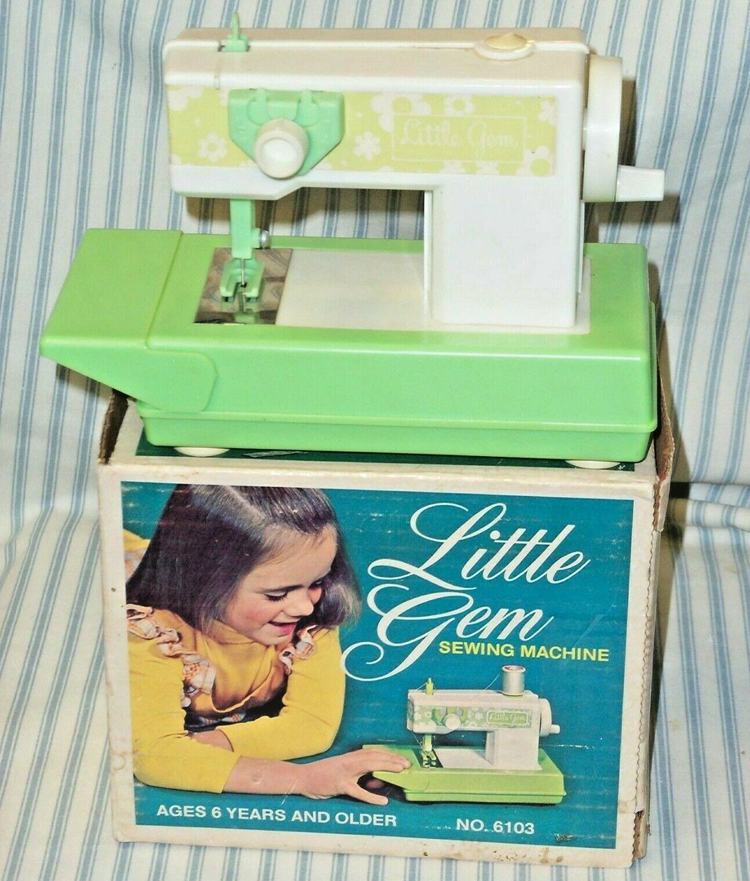
This White sewing machine was possibly the most peculiar since it was so tiny and featured a cast iron base or possibly a wooden plinth.
Its manufacturing began in the late 1800s, although it was not as popular as other varieties of White sewing machines.
It employs comparable technology to the Peerless machine but has the Gem branding.
1810 White Jeans Machine
This kind of White sewing machine comes with a few stitch patterns that you may use, but the lack of variety is one of the machine’s flaws.
It could do a straight stitch and a zig-zag pattern, but there were a few different stitch styles to choose from.
The owner’s handbook is still accessible, and it demonstrates that this machine was designed with simplicity in mind, with all controls conveniently located.
You may adjust the stitch length and width of the zig-zag stitch, but this is a plain Jane sewing machine in terms of whistles and bells.
Early 20th-century Electric Machines
White began making sewing machines with electric motors in the 1920s to make household sewing speedier and less labor-consuming.
In contrast to the previous polished and detailed appearance, the metal of these early electric antique White machines has a crinkled surface and cast scrollwork decoration.
From 1924 until the 1930s, White manufactured all of the sewing machines marketed by Sears. Franklin, Minnesota, and Kenmore sewing machines from the 1930s through the 1950s are actually old White sewing machines.
Japanese White Sewing Machines
Following WWII, the White Sewing Machine Company released revolutionary sewing machine technology, including zigzag stitching.
Zigzag stitches were created by placing a tiny plastic cam into the machine to regulate the movement of the needle.
These antique White zigzag stitch sewing machines provide a choice of stitches as well as dependable mechanics.
Many 1950s antique sewing machines were clones of the White zigzag sewing machine. Less costly Japanese sewing machines subsequently dominated the White Sewing Machine and American market firm combined with the Norwegian Husqvarna-Viking.
How Do You Identify The Year Of Your White Sewing Machine?
Since there were few unique models, knowing the year of manufacture of your White sewing machine is easy.
Each machine comes with a manufacturer’s tag with a serial number that may be used to pinpoint the exact year of creation.
Depending on the model, the tag will be situated at the front, back, or engine of the sewing machine.
If you have a unique model, it might be on either side or even at the bottom, however, this is quite rare.
Once you’ve identified the serial number of your White sewing machine, look it up online to find the year of manufacture.
The only issue you could run into is if your machine was manufactured after the 1960s when Husqvarna-Viking purchased the White Sewing Machine firm.
Husqvarna-Viking does not provide any information on the year of manufacture for their sewing machines.
Therefore you’d have to locate an appraiser that specializes in White sewing machines to assist you in determining the year of manufacture.
What Is the Value of a White Sewing Machine?
Prices for white sewing machines range from around $100 to over $1000.
If you already own a machine, are considering buying or selling one, or are simply curious about its worth, it’s a good idea to familiarise yourself with the factors that may impact its value.
Factors Influencing The Value Of White Sewing Machines
Every machine’s value is defined by its model, age, and condition. consider the following elements:
Rarity
Some rare machines, like the gem, are more valuable than others. The White Rotary Machine, which was made in vast quantities, is more common and hence less valuable than previous models.
Condition
When all other things are considered, a machine in good working order is always worth more than an equivalent model in poor condition.
Furthermore, for a machine to be the most valuable, it should be visually appealing, with clear, beautiful decals and in good condition paint.
Age
Older machines are typically more valued. Many devices have at least one patent and date inscribed on them, but the serial number can tell you how old your equipment is.
Functionality
Lastly, the value of a sewing machine is influenced by its usefulness. White sewing machines that are in functioning order, or completely functional, will always be more valuable than those that aren’t.
Although white sewing machines aren’t popular among collectors, they’re mostly purchased to be utilized.
As a result, the functionality of antique devices has a greater impact on their worth than the functioning of other vintage items.
Recent Machine Sales And Prices
In general, looking up recently sold machines on eBay is the best approach to determine the value of a vintage White sewing machine.
Compare the worth of your computer against others of the same age, model, and condition. Here are a few recent sales:
- Over $470 was paid for a White peerless antique sewing machine. It was totally functional and in stunning condition.
- A White Rotary sewing machine‘s value might be deceiving. One in good condition went for $800, while the most go for far less.
Where Can You Purchase And Sell White Sewing Machines?
If you’re considering buying a White sewing machine or feel you have a one-of-a-kind model gathering dust in your garage, there are several online marketplaces where you can buy or sell it. Here are our top two picks:
ebay.com
eBay is a well-known online marketplace, with people from all around the world selling items such as White sewing machines.
On eBay right now, there are over 100+ ads for antique White sewing machines.
Etsy.com
Etsy is another amazing internet marketplace to think about. White sewing machines are common on Etsy.
There are thousands of active ads, and you’re sure to discover a White sewing machine that meets your requirements among them.
Purchasing A Vintage Sewing Machine
Here are some things to think about and keep an eye out for while shopping for a vintage sewing machine.
What To Search For
Purchasing an old sewing machine brings back memories. It’s almost as though you’re holding a piece of history in your hands.
Furthermore, the craftsmanship is unrivaled. The older the equipment, the better its general design and construction. Those produced between the 1920s and the 1950s were extremely well-engineered. They frequently require very little upkeep.
Here are a few more things to check for when purchasing a vintage sewing machine.
- As it is all constructed of metal, it should be heavy.
- The handwheel should turn smoothly.
- The needle bar should move easily up and down.
- With each handwheel spin, the feeding dogs and bobbin case should move.
- Decal wear is undesired but tolerable.
What To Avoid,
Unfortunately, there are several things to avoid while hunting for a vintage machine. Here are several examples:
- Missing, twisted, or shattered components
- Holes when screws or other pieces are missing
- Plastic light machines
- Significant blemishes or dents
- Brands whose replacement parts are difficult to get by
White Sewing Machine Serial Number Value
The serial number is the best way to determine the value of a White sewing machine.
The model and year of production are indicated by the number, which is two of the most essential criteria influencing its worth.
As you can see, the more precious the machine, the older it is. Remember that these are only average price ranges, and many White sewing machines can be purchased or sold for more or less.
Here’s a list of White sewing machine values organized by serial number:
| Serial Number Date of Production Average Value Range
1. 1-9,000 1876 $300-$5,000 2. 2,300,001-4,000,000 1914-1918 $100-$400 3. 63,001-370,000 1880-1883 $100-$800 4. 9,001-63,000 1877-1879 $100-$1,000 5. 970,001-1,550,00 1894-1903 $100-$500 6. 370,001-970,000 1884-1893 $100-$500 7. 1,550,001-2,300,000 1904-1914 $100-$400 |
Do White Sewing Machines Still Exist?
No, the company was bought by Electrolux in 1986 and no longer exists. When White bought Westinghouse from GM in 1975, they developed the White Westinghouse brand.
However, it is not used on their sewing machine lines. Electrolux employs the White Westinghouse brand, but not for sewing machines.
The Husqvarna-Viking brand name is used for sewing machines, which are at the lowest end of the quality spectrum.
Since being acquired by Husqvarna-Viking in 2006, the White sewing machine brand has not produced new models.
SVP Worldwide owns Pfaff, Husqvarna-Viking, and Singer, and owner’s manuals for all of their sewing machines, including old Whites, are available on the Singer website.
Did White Make Domestic Sewing Machines?
White, like many other sewing machine makers, produced and branded a large number of sewing machines for merchants.
White continued to produce the Domestic-made Franklin sewing machines for Sears Roebuck & Co. after acquiring the Domestic Sewing Machine Company of Buffalo, New York, in 1924.
The White firm continues to manufacture domestic-made Franklin sewing machines for Sears Roebuck & Co. White owned Domestic completely. Over the next 12 years, White provided around 20% of Sears’ sewing machine output.
The Great Depression reignited interest in home sewing. White continued to develop, inventing the first sewing machine that was composed of a magnesium alloy and was significantly lighter than its competitors.
How Do You Apply Oil On A White Rotary Sewing Machine?
Remove any remaining fluff or dust from your White Sewing Machine. Replace the lid and fasten it with the latches after restoring the hook in the race.
One drop of oil should be applied to the friction points where the hook contacts the race. Rotate the flywheel a few times by hand to distribute the oil throughout the race.
Why Isn’t Your Bobbin Winding?
The bobbin winder may not be properly engaged if the bobbin does not wind swiftly and smoothly when you push the foot pedal.
This may cause unequal winding. To activate your bobbin winding mechanism, ensure sure your bobbin pin is fully extended or your bobbin wheel is completely loose.
Conclusion
White Sewing machines Company and sewing machines have a long and illustrious history. Beginning in the nineteenth century, the firm produced low-cost sewing machines so that every sewer might find relief from their sewing tasks.
The good news is that many of those ancient machines were made using meta components and, if found, still operate today. The bad news is that White did not produce Bernina-quality sewing machines.
His machines may not operate as well as other brands, as several sewers have stated. On the plus side, White machines are quite dependable and can get the job done even if the results aren’t up to par.
Learning about vintage sewing machines is interesting, whether you have a gem or merely a unique piece of early craftsmanship.
White was only one of several historical sewing machine brands. Singer, National, Willcox and Gibbs, and many others were among the others. These firms collaborated to develop the innovations required for current sewing machines.




![Where To Sell Antique Furniture In 2022 [Ultimate Guide]](https://www.jacquelinestallone.com/wp-content/uploads/2022/09/Etsy-Your-Place-To-Buy-And-Sell-All-Things-Handmade-600x450.jpg)



